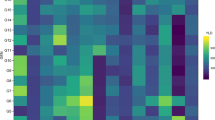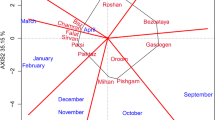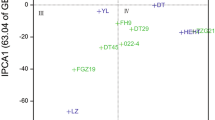Abstract
Ten field pea genotypes were evaluated in randomized complete block design with four replications for three consecutive years (2010-2012) main cropping seasons at four locations in each year. The objectives were to determine magnitude of genotype by environment interaction and to identify stable field pea genotype with high grain yield to be released as a cultivar to producer for Northwestern Ethiopia. The GGE [genotype main effect (G) and genotype by environment interaction (GE)] biplot graphical tool was used to analyze yield data. The combined analysis of variance revealed a significant difference (P<0.01) among genotypes, environments and genotype-by-environment interaction for grain yield. The average environment coordinate biplot revealed that EH99005-7 (G2) was the most stable and the highest yielding genotype. Polygon view of GGE-biplot showed the presence of three mega-environments. The first section includes the test environments E1 (Adet 2010), E3 (Debretabor 2010), E5 (Adet 2011), E6 (Motta 2011), E7 (Debretabor 2011), E8 (Dabat 2011), E9 (Adet 2012) and E12 (Dabat 2012) which had the variety G1 (EH99009-1) as the winner; the second section contains the environments E4 (Dabat 2010), E10 (Motta 2012) and E11 (Debretabor 2012) with G2 as the best grain yielder and the third section contains the E2 (Motta 2010) with G4 (Tegegnech X EH90026-1-3-1) as the best grain yielder. The comparison GGE- biplot of field pea genotypes with the ideal genotype showed that G2 was the closest genotype for the ideal cultivar. Among the twelve environments, E2, E6 and E10 were more discriminating and E3, E9 and E12 were less discriminating. Genotype EH99005-7 was the most stable and the highest yielding genotype. As a result it is released officially for Northwestern Ethiopia. Therefore, it is recommended to use genotype EH99005-7 for wider cultivation in Northwestern Ethiopia and similar areas.
Similar content being viewed by others
References
Asfaw T, Tesfaye G, Beyene D. 1994. Genetics and breeding of field pea. In: A Telaye, G Bejiga, S. Mohan, S. Mohmoud, eds, Cool Season Food Legumes of Ethiopia. Procedings of the First National Cool-Season Food Legumes review Conference, 16-20 December, 1993, Addis Abeba Ethiopia. ICARDA/Institute of Agricultural Research. ICARDA, Aleppo, Syria, pp 285–214
Butrón A, Velasco P, Ordás A, Malvar RA. 2004. Yield evaluation of maize cultivars across environments with different levels of pink stem borer infestation. Crop Sci. 44: 741–747
Central Statistical Agency (CSA). 2015. Agricultural Sample survey, 2008/9. Report on area and production of crops. Statistical Bulletin No. 446, Volume I, Addis Ababa, 12 p
Ceyhan E, Kahraman A, Ates MK, Karadas S. 2012. Stability analysis on seed yield and its components in peas. Bulg. J. Agric. Sci. 18: 905–911
Fan XM, Kang MS, Chen H, Zhang Y, Tan J, Xu C. 2007. Yield stability of maize hybrids evaluated in multi–environment trials in Yunnan, China. Agron. J. 99: 220–228
Gauch HG, Zobel RW. 1997. Identifying mega-environments and targeting genotypes. Crop Sci. 37: 311–326
Girma T, Getachew T, Geletu B. 2000. AMMI adjestement for yield estimate and classification of genotypes and environments in field pea (Pisum sativum L.). J. Genet. Breed. 54, 183–191
Gomez KA, Gomez AA. 1984. Statistical Procedures for Agricultural Research, 2nd edn. John Wiley and Sons, New York
Kroonenberg PM. 1995. Introduction to biplots for GXE tables. Research Report No. 51, Centre for Statistics, The University of Queensland, Australia
Mulusew F, Edoossa F, Tadele T, and Teshome L. 2009. Parametric Stability in field pea (Pisum sativum L.) under South Eastern Ethiopia Conditions. World J. Agric. Sci. 5: 146–151
Mulusew F, Tadele T, Setegn G, Bekele H. 2010. Agronomic performances, disease reaction, yield stability of field pea (Pisum sativum L.) genotypes in Bale Highlands, Ethiopia. Aust. J. Crop Sci. 4: 238–246
Mussa J, Tezera W, Gemechu K. 2006. Review of field pea (Pisum sativum L.) genetics and breeding research in Ethiopia: A review. In: A Kemal, K Gemechu, A Seid, R Malhotra, S Beniwal, K Makkouk, MH Halila, eds., Food and Forage Legumes of Ethiopia: Progress and Prospects. Proceedings of a Workshop on Food and Forage Legumes, 22-26 Sept. 2003, Addis Ababa, Ethiopia, ICARDA, Aleppo, Syria, pp 67–79
Samonte SOPB, Wilson LT, McClung AM, Medley JC. 2005. Targeting cultivars onto rice growing environments using AMMI and SREG GGE biplot analysis. Crop Science 45: 2414–2424
Tezera W. 2000. Genotype by Environment interaction in field pea (Pisum sativum L.) for yield and other traits across central and southern Ethiopia. M.Sc. Thesis. Alemaya University of Agriculture, Dire Dewa
Tolossa TT, Kenani G, Sefera T, Jarso M and Bekele Y. 2013. Genotype x environment interaction and performance stability for grain yield in field pea (Pisum Sativum L.) genotypes. Int. J. Plant Breed. 7: 116–123
Yan W. 2001. GGEBiplot―A Windows application for graphical analysis of multi-environment trial data and other types of two-way data. Agron. J. 93: 1111–1118
Yan W. 2002. Singular-value partitioning in biplot analysis of multi-environment trial data. Agron. J. 94: 990–996
Yan W, Hunt LA. 2001. Genetic and environmental causes of genotype by environment interaction for winter wheat yield in Ontario. Crop Sci. 41: 19–25
Yan W, Kang MS. 2003. GGE biplot analysis: a graphical tool for breeders, In: MS Kang, eds., Geneticists, and Agronomist. CRC Press, Boca Raton, FL
Yan W, and Rajcan I. 2002. Biplot evaluation of test sites and trait relations of soybean in Ontario. Crop Sci. 42: 11–20
Yan W, Tinker NA. 2006. Biplot analysis of multi-environment trial data: Principles and applications. Can. J. Plant Sci. 86: 623–645
Yan W, Hunt LA, Sheng Q, Szlavnics Z. 2000. Cultivar evaluation and mega-environment investigation based on GGE biplot. Crop Sci. 40: 596–605
Author information
Authors and Affiliations
Corresponding author
Rights and permissions
About this article
Cite this article
Yihunie, T.A., Gesesse, C.A. GGE Biplot Analysis of Genotype by Environment Interaction in Field Pea (Pisum sativum L.) Genotypes in Northwestern Ethiopia. J. Crop Sci. Biotechnol. 21, 67–74 (2018). https://doi.org/10.1007/s12892-017-0099-0
Received:
Revised:
Accepted:
Published:
Issue Date:
DOI: https://doi.org/10.1007/s12892-017-0099-0




